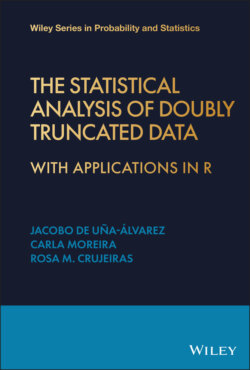Читать книгу The Statistical Analysis of Doubly Truncated Data - Prof Jacobo de Uña-Álvarez, Prof Carla Moreira - Страница 13
1.2 One‐sided Truncation 1.2.1 Left‐truncation
ОглавлениеLeft‐truncation is a common feature when sampling time‐to‐event data. A left‐truncation time for the target is defined as a random variable such that is observed only when , determining the random set in the previous section.
Left‐truncation occurs, for example, with cross‐sectional sampling, where the sampled individuals are those being between the origin and the end point at a certain calendar time, which is the cross‐section date (Wang, 1991). That is, the observer arrives at the process at a given date, being allowed to observe the time‐to‐event and the left‐truncation time for the individuals 'in progress' by that date. With cross‐sectional sampling, the variable is simply defined as the time from onset to the cross‐section date. This sampling procedure is often applied because it entails relatively little effort to reach a pre‐specified sampling size. In medical research, such a design leads to the sampling of the so‐called prevalent cases: patients already diagnosed from a certain disease of interest who survived beyond the cross‐section date. Clearly, such a sampling design implies an observational bias, in the sense that individuals with longer survival (the value) will be observed with a relatively large probability. There exist well investigated proposals to overcome such a bias, based on the simple idea of taking the observed left‐truncation times into account to define suitable risk sets. For this purpose, independence between and has been traditionally assumed. This independence assumption states that the time‐to‐event distribution remains unchanged along time, being unrelated to the date of onset. A classical example of left‐truncation are the Channing House data, where the age at death is measured for people living in that retirement centre; in this case, the target variable is left‐truncated by the age when entering the residence (Klein and Moeschberger, 2003).
Another feature leading to left‐truncation is the delayed entry into study. This happens when the individuals enter the study only at some random time after onset. For example, diagnosis of a certain disease may not be ascertained until the first visit to the hospital. If the 'end‐of‐disease' event occurs before the potential date of visit, the time‐to‐event of such a patient will be never known, with the resulting difficulty in observing relatively small event times. Beyersmann et al. (2012) provide an illustrative example of this issue in the investigation of abortion times.
